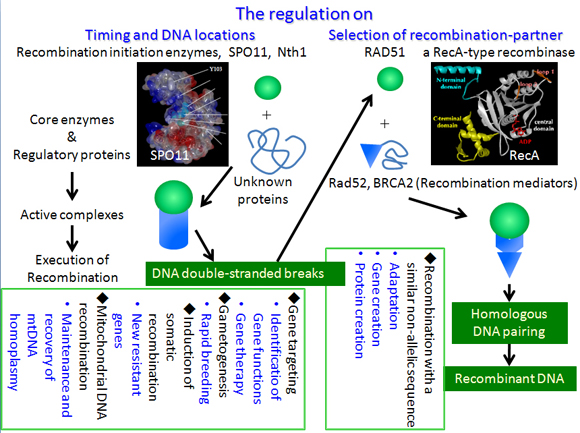Project
![]() [Shibata group]
[Shibata group]
Functions of ID regions in homologous DNA recombination
Group leader : Takehiko Shibata (Unit Leader, RIKEN Advanced Science Institute)
Group member : Kohji Kusano (Professor, Kyoto Institute of Technology)
Group member : Jin Inoue (Contract Researcher, RIKEN Advanced Science Institute)
Group member : Kohji Kusano (Professor, Kyoto Institute of Technology)
Group member : Jin Inoue (Contract Researcher, RIKEN Advanced Science Institute)
Homologous DNA recombination is a rearrangement of genomic information by breakage-and-rejoining of two DNA molecules at their common sequences, and a general genetic phenomenon observed in all DNA genomes. Most homologous recombination is not a random event, but is precisely regulated in time and genomic location by cell signaling networks responding to the environment. As the targets of the regulation, we are focusing on DNA double-stranded breakage at recombination "hot spots," and the subsequent homologous DNA pairing. Homologous DNA pairing is a DNA reaction to generate a general recombination-intermediate, by which a 3' single-stranded DNA tail derived from a strand-break invades into intact homologous double-stranded DNA and pairs with the complementary sequence. Then, the 3' terminus serves as a primer to start repair DNA synthesis to resume the base-sequence lost by the strand-break. The major player to promote homologous pairing is a member of RecA/RAD51/DMC1-family proteins through an ATP-dependent reaction. SPO11 specifically expressed in meiosis was the only known protein responsible for specific double-stranded cleavage to initiate recombination. We recently found that NTG1 (a homologue of E. coli endonuclease III) introduces a double-stranded break at a specific site in DNA to initiate somatic homologous recombination in the mitochondria under the regulation mediated by ROS (Reactive Oxygen Species). Recombination functions promoted by core proteins, RecA/RAD51/DMC1 (and probably SPO11) were found to be regulated by interacting with various regulatory proteins at putative intrinsic disordered regions. In this research topic, we will study the functions of the interactions at the ID regions in homologous recombination. We will analyze the interactions between proteins and between proteins and DNA, and their genetic consequences by both physicochemical or biochemical means, and genetic means by use of Drosophila, a well studied model organism. Through these studies, we will understand the principles of the regulation on homologous recombination, and based on the principles, we will contribute to develop new genome technology.
